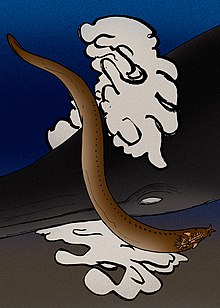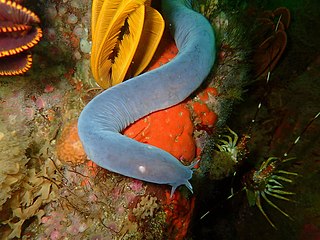
Hagfish, of the class Myxini and order Myxiniformes, are eel-shaped jawless fish. Hagfish are the only known living animals that have a skull but no vertebral column, although they do have rudimentary vertebrae. Hagfish are marine predators and scavengers who can defend themselves against other larger predators by releasing copious amounts of slime from mucous glands in their skin.

Agnatha is a paraphyletic infraphylum of non-gnathostome vertebrates, or jawless fish, in the phylum Chordata, subphylum Vertebrata, consisting of both living (cyclostomes) and extinct. Among recent animals, cyclostomes are sister to all vertebrates with jaws, known as gnathostomes.

Avisaurus is a genus of enantiornithine avialan from the Late Cretaceous of North America.
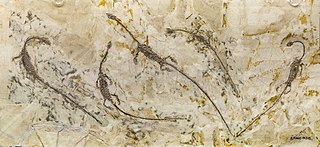
Hyphalosaurus is a genus of freshwater aquatic reptiles, belonging to the extinct order Choristodera. They lived during the early Cretaceous period, about 123-120 million years ago. The genus contains two species, H. lingyuanensis from the Yixian Formation and H. baitaigouensis from both the Yixian and Jiufotang Formation of Liaoning Province, China. They are among the best-known animals from the Jehol Biota, with thousands of fossil specimens representing all growth stages in scientific and private collections.

Protostega is an extinct genus of sea turtle containing a single species, Protostega gigas. Its fossil remains have been found in the Smoky Hill Chalk formation of western Kansas, time-equivalent beds of the Mooreville Chalk Formation of Alabama and Campanian beds of the Rybushka Formation. Fossil specimens of this species were first collected in 1871, and named by Edward Drinker Cope in 1872. With a total length of 3.9 metres (13 ft), it is the second-largest sea turtle that ever lived, second only to the giant Archelon, and one of the three largest turtle of all time along Archelon and Gigantatypus.
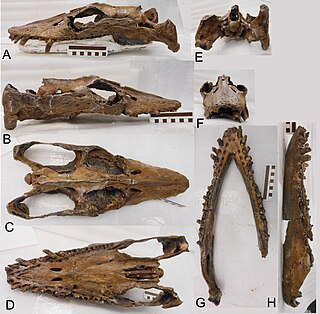
Libonectes is an extinct genus of sauropterygian reptile belonging to the plesiosaur order. It is known from specimens found in the Britton Formation of Texas (USA) and the Akrabou Formation of Morocco, which have been dated to the lower Turonian stage of the late Cretaceous period.
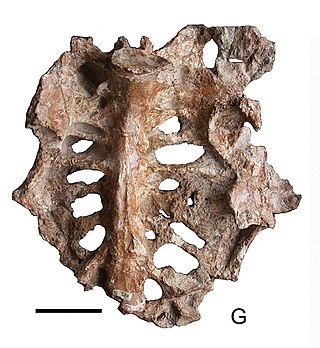
Gargantuavis is an extinct genus of large, primitive bird containing the single species Gargantuavis philoinos. It is the only member of the monotypic family Gargantuaviidae. Its fossils were discovered in several formations dating to 73.5 and 71.5 million years ago in what is now northern Spain, Southern France, and Romania. Gargantuavis is the largest known bird of the Mesozoic, a size ranging between the cassowary and the ostrich, and a mass of 141 kg (311 lb) like modern ostriches, exemplifying the extinction of non-avian dinosaurs wasn't a necessary condition for the emergence of giant terrestrial birds. It was once thought to be closely related to modern birds, but the 2019 discovery of a pelvis identified as cf. Elopteryx nopcsai from what was Hateg Island shows several primitive features.
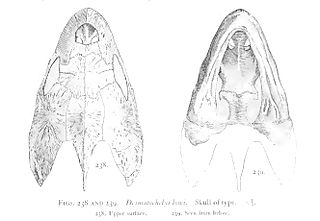
Desmatochelys is an extinct genus of sea turtles belonging to the family Protostegidae. This genus contains two known species, D. lowii and D. padillai. D. lowii was first discovered in 1895, followed by D. padillai in 2015. Having been estimated at over 120 million years old, D. padillai is currently the oldest known species of sea turtle.

Cratochelone is an extinct genus of sea turtle in the family Protostegidae and containing a single species Cratochelone berneyi. The species is known only from the mid to late Albian Toolebuc Formation, part of the Rolling Downs Group, in the Hughenden of Central northern Queensland, Australia.

Terminonaris is a genus of extinct pholidosaurid crocodyliforms that lived during the Late Cretaceous epoch. The name means: “enlarged snout or nose” at the front of the skull. Terminonaris is an early crocodile, within a subgroup called Mesoeucrocodylia. Its remains have only been found in North America and Europe. Originally known under the generic name Teleorhinus, it was once believed to be a teleosaurid. Both prehistoric crocodiles such as Terminonaris, as well as modern crocodiles, belong to the same group called crocodyliformes, although modern crocodiles have specific features that indicate they are distant relatives of this species and members of the subgroup Eusuchia.

Metaspriggina is a genus of chordate initially known from two specimens in the Middle Cambrian Burgess Shale and 44 specimens found in 2012 at the Marble Canyon bed in Kootenay National Park.

Diplocercides is an extinct genus of marine coelacanth which lived during the Late Devonian period.

Carsosaurus is a genus of extinct amphibious reptiles, in the mosasaur superfamily, containing only the species Carsosaurus marchesetti. It is known from a single individual that lived during the Upper Cretaceous in what is now Slovenia. The specimen is well-preserved, containing many different bones as well as some skin impressions and sternal cartilage. While more remains are needed to be certain, it is generally thought to belong to the Aigialosauridae. In life, it was an amphibious creature that spent most of its time on land, although its later relatives would become fully aquatic.
Clupavus is an extinct genus of marine ray-finned fish that lived during the middle of the Cretaceous period. It is known from North Africa, Europe, Brazil, and possibly North America.
Rubicundus is a genus of hagfishes, the only extant member of the subfamily Rubicundinae. All species in it were formerly classified in Eptatretus. R. eos, R. lakeside, and R. rubicundus are known from single specimens caught in the Tasman Sea, Galápagos, and Taiwan, respectively. They are named after the distinctive red coloration that all species share.

Archaeornithura is an extinct genus of ornithuromorphs from the early Cretaceous period. It is known from two fossil specimens of a single species, Archaeornithura meemannae. The specimens have been dated to the Hauterivian age, 130.7 million years ago, making A. meemannae the oldest known ornithuromorph, the lineage that gave rise to modern birds, and contains all living birds as well as many of their extinct relatives.
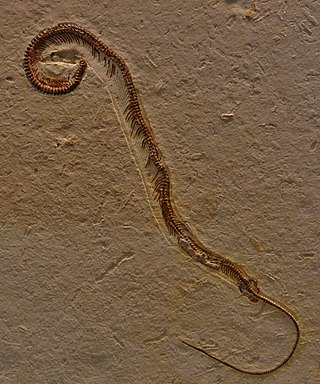
Tetrapodophis is an extinct genus of lizard from the Early Cretaceous (Aptian) aged Crato Formation of Brazil. It has an elongated snake-like body, with four disproportionately short limbs.
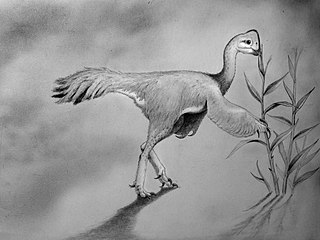
Leptorhynchos is an extinct genus of caenagnathid theropod from the Late Cretaceous of what is now the US state of Texas, although it has been suggested to also exist in Alberta and South Dakota. The type species is L. gaddisi, and it is currently the only widely accepted valid species. The generic name of Leptorhynchos comes from the Greek "leptos" meaning "small" and "rhynchos" meaning "beak". The specific epithet is in honor of the Gaddis family, who owned the land on which the holotype was discovered.

Myxinikela is an extinct genus of stem-hagfish known from the Late Carboniferous of Illinois, USA. It is the earliest definitive hagfish known from fossil remains, and one of only two alongside the Cretaceous crown-group hagfish Tethymyxine.

Fona is an extinct genus of thescelosaurine thescelosaurid ornithischian dinosaurs from the 'mid'-Cretaceous Cedar Mountain Formation of Utah, United States. The genus contains a single species, F. herzogae, known from several partial skeletons and skulls. Based on anatomical similarities to the closely related and similarly aged Oryctodromeus, Fona was likely a semi-fossorial animal, likely spending a significant amount of time in underground burrows. It also represents the oldest known definitive thescelosaurine.
